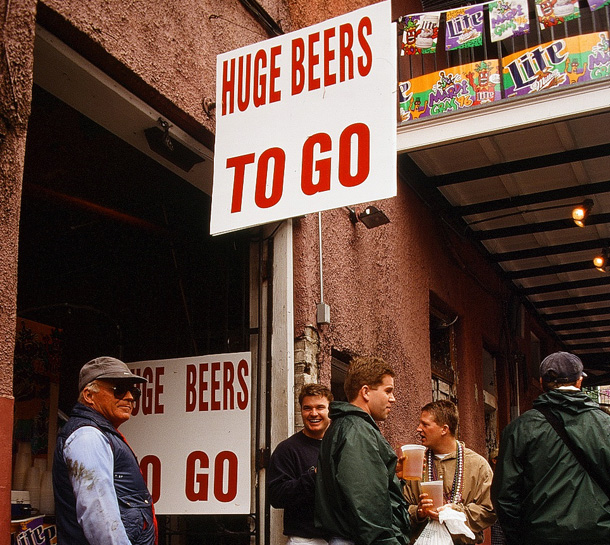03.04.19, BEER AND WINE LINKS

This photo was taken during Mardi Gras in New Orleans in 1996. The ongoing battle of Huge Ass Beers vs. Giant Ass Beer suggests how timeless New Orleans can be.
Reisch family celebrates revival of Gold Top beer with last brewmaster, now 100.
“This is Springfield’s own. It was brewed in Springfield for 117 years. And with the family being instrumental and the last brewmaster turning 100, it was the right time to bring it back.” Profits from the sale of Gold Top will be used to preserve Springfield’s historic sites. There’s something to be said for nostalgia.
Why authenticity is for tourists.
An engaging tale that may cause you to think about what it means to be authentic. Sorry, didn’t mean to give you a headache to begin the week. For a story a few years back about how the words craft and beer began to travel together Mike Kallenberger of Tropos Brand Consulting said, “I’d argue that craft beer as a category has a collective brand identity, and one of the most important values implicit is that identity is authenticity.” And here Will Hawkes writes, “Authenticity appears to be in the ascendancy at the moment because, in my view, there’s only so much worthwhile innovation around before you end up with marshmallows in your beer.”
Guild Announces 2019 Diversity in Beer Writing Grant.
The North American Guild of Beer Writers is now accepting applications for its second Diversity in Beer Writing Grant. The winner of the grant will receive a cash stipend for completed work, which will be published on CraftBeer.com. This story, Pride, Not Prejudice: Brewing Safe Spaces for the LGBTQ+ Community, resulted from last year’s competition.
Beer and Buds in Juneau, Alaska.
For whatever reason, I started with the Spanish version of this story and discovered Good Beer Hunting is going bilingual.
Bud Light brings its anti-corn syrup, anti-Miller Lite campaign to Milwaukee.
Big Beer’s festering corn-fueled controversy: How we got here.
Containing a Kernel: Bud Light’s New Ad is Really Old.
This story just keeps on giving. Anheuser-Busch has taken the fight to Milwaukee (Link #1), and there’s so much going on that a recap (#2) is in order. Finally, Brian Alberts steps back in time to document how “debates over beer have specifically manipulated public perception about the brewing process for the last 150 years.” He could have gone back either further. In Upper Hudson Valley Beer authors Craig Gravina and Alan McLeod write about charges related to the adulteration of beer in Albany in the 1830s.
Stephen Beaumont & Jay Brooks on Flagship February.
In Like A Lamb And Out With A Better Sense Of The Money Makers.
Pour One Out for the Fading American Beer Industry.
What comes after #FlagshipFebruary? Perhaps #FlagshipFriday at the beginning of every month. Stephen Beaumont and Jay Brooks don’t yet have a plan, but promise there will be one by April. Alan McLeod (Link #2) proposes #MoneyMakerMarch, and examining the financial part of the beer equation. Plenty of would-be professional brewers are still interested in entering the business, although I hope they aren’t basing it on the return Bill Owens once suggested was standard. And perhaps they should also read what’s behind Door #3. Stick with it for a rather ominous prediction near the end.
“For years, alcohol consumption followed a steady path as adults developed drinking habits: cheap beer in high school and college, better beer after getting a job, maybe $10-a-bottle wine for early adulthood dinner parties and then onto more upscale spirits and better wine as age and salary rise. That cycle is in danger of being broken if the new generation of drinkers never breaks through with cheap beer.” The current slump is “a canary in the coal mine.”
NAVEL GAZING
How does the public think journalism happens?
Different parts of this conversation overlap, so a second link about the demise of beer in print seems in order. And a survey by Columbia Journalism review indicates that journalism isn’t exactly on a roll. If your scroll down, you’ll see 60 percent of respondents believe reporters get paid by their sources sometimes or very often. I must be doing something wrong, but it would seem there is a reason people would believe this. Witness this:
Just spoke with @tacobell PR for a story I'm reporting. The guy on the other end of the line asked how much it will cost to be included the story. FOR THE RECORD: We don't pay sources nor do they pay us.
— Kim Severson (@kimseverson) March 1, 2019
WINE
A clichéd natural wine producer review.
Warning: Contains satire. “There is no label: instead they write the name of the wine on each bottle individually using a white marker pen, a process that seemed a good idea at the time but which they admit is now a time-consuming chore.”
FROM TWITTER
Yup, we are the only distillery that plays live Trad to the wort for extra Irishness. pic.twitter.com/sKVQzDIrYO
— BlackwaterDistillery (@BlackDistillery) March 1, 2019
And returning to the subject of what dismays those trying to make a money as a writer:
Another day, another massive pirate site positively laden with my eBooks, and with the eBooks of others, including work from small presses and a variety of anthologies. Gosh, what fun.
— Seanan McGuire (@seananmcguire) March 2, 2019
MORE LINKS
ReadBeer, every day.
Alan McLeod, most Thursdays.
Good Beer Hunting’s Read Look Drink, most Fridays.
Boak & Bailey, most Saturdays.